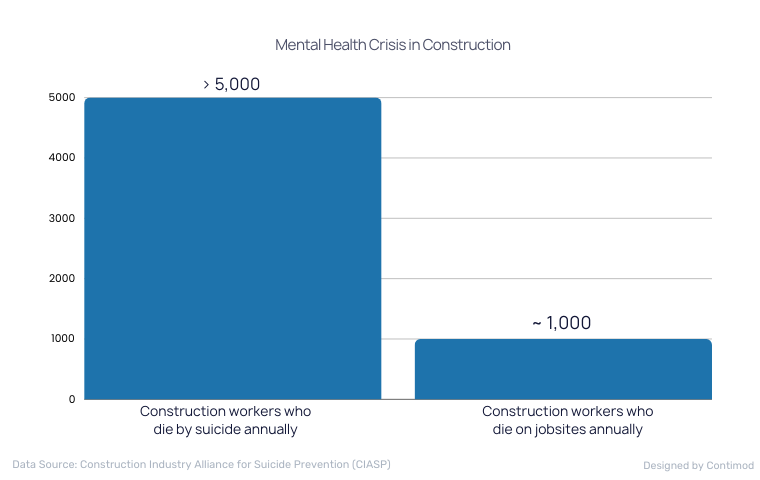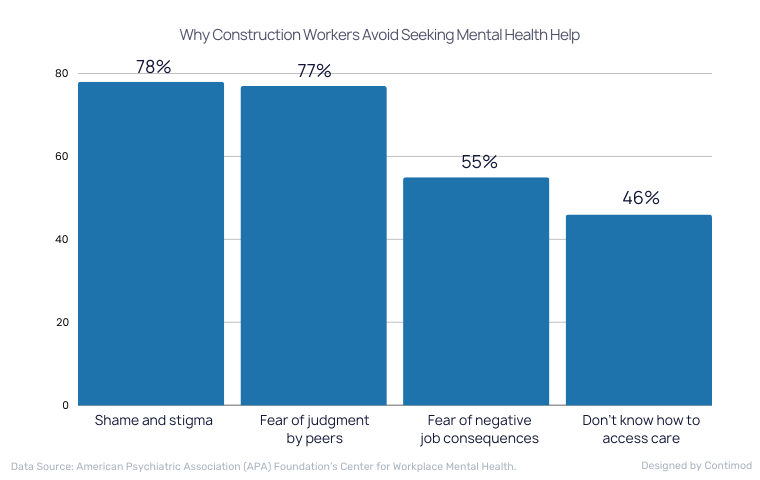Construction Mental Health Statistics: A Must Know (2024)
Mental health is frequently overlooked in the construction industry despite its significant impact on workers. But just how widespread are these mental health issues, and what do the numbers reveal?
With that in mind, we’ll cover key construction mental health statistics that show the challenges construction professionals are facing.
Construction Mental Health Statistics: Key Numbers
- 83% of construction workers have experienced a mental health issue.
- Over 6,000 people working in construction die by suicide in 2022.
- Construction has one of the highest suicide rates (53.3 per 100,000 U.S. workers).
- The suicide rate of male construction workers is 75% higher than the general population.
- 14.3% of construction workers had anxiety and 6% had depression.
- 21-60% of construction workers experience moderate to severe psychological distress.
- 15% of workers in the construction industry are impacted by substance abuse, with 8.6% of people as the national average.
Source: (National Academy, CDC, EHS Insight, NCBI, Construction Dive, Associated General Contractors of America)
Mental Health Issues Affecting Construction Workers
Construction workers are dealing with serious mental health problems from depression to anxiety and PTSD making their jobs even more challenging. Here are the key mental health stats from the CDC:
- 10–38% of construction workers experience depression.
- 19–42% of construction workers experience anxiety.
- 7–11% of construction workers experience PTSD.

Source: CDC
Why Construction Workers Avoid Seeking Mental Health Help
Construction workers often avoid getting mental health help because of fear of being judged and worries about their job security, which makes it hard for them to seek care. Here’s what they’re dealing with:

- 78% of construction workers don’t seek care due to shame and stigma.
- 77% avoid seeking help because of fear of judgment by peers.
- 55% are concerned about negative job consequences if they seek help.
- 46% don’t know how to access care when needed.
Source: American Psychiatric Association (APA) Foundation’s Center for Workplace Mental Health.
Construction Workplace Mental Health: Who Cares Most?
Mental health is becoming a focus for many construction professionals. And the level of concern for mental health differs across job types. Here are the leaders who prioritize mental health in the workplace:
- 77% of Presidents/CEOs/Owners agree with prioritizing mental health at work.
- 72% of Safety/Risk Management professionals agree with prioritizing mental health at work.
- 69% of HR/Benefits Coordinators agree with prioritizing mental health at work.
- 56% of Field Management/Supervision professionals agree with prioritizing mental health at work.
- 48% of CFOs/Controllers or Finance/Accounting professionals agree with prioritizing mental health at work.

Source: Workplace Mental Health
Suicide By Occupation
The connection between job type and suicide rates reveals alarming trends in some occupations. Take a look at the occupations where men and women are most affected:
| Occupation | Suicide Rate (Men) | Suicide Rate (Women) |
|---|---|---|
| Construction & Extraction | 49.4% | 25.5% |
| Installation, Maintenance & Repair | 36.9 | N/A |
| Arts, Design, Entertainment, Sports & Media | 32 | 8.8 |
| Farming, Fishing & Forestry | 31.4 | N/A |
| Transportation & Material Moving | 30.4 | 12.5 |
Source: CDC Via ConstructConnect
